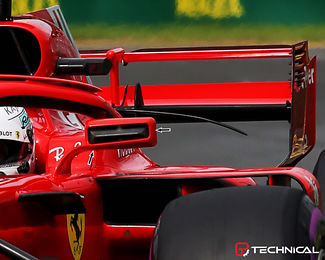How Ferrari's vented rear view mirrors really work
A lot has been said about Ferrari's innovative wing mirrors. Changes like this are hard to come by these days in Formula One, but Ferrari have certainly thought out of the box here. While all other teams have their mirror housings as round as possible, to limit drag created by them, Ferrari's items feature a small gap all around the actual mirror. The traditional mirrors guide all air around the housing, whereas with Ferrari's new design, some airflow flows through the housing.
While it's obviously easy to spot thanks to Ferrari not painting the inner fairing, it brings us to the next question of what is actually the purpose of the design.
The most widely spread idea seems to be bending of air into the upper sidepod inlet, but some closer views at the relative position of these two elements make this very unlikely, as the curve would have to be quite sharp, requiring something like a proper wing rather than just a vent through the housing of a simple mirror.
Dismissing this, drag reduction seems to be the most obvious reason. In fact, Red Bull are reducing the frontal surface of the mirrors by angling them more, precisely to reduce this drag. But then, why doesn't Ferrari just do the exact same thing?
The answer is more complicated than it looks, so some CFD analysis by Vanja Hasanovic reveals a few interesting, and perhaps unexpected results of the new design. First of all, drag seems to be increased. Secondly, air is indeed drawn downward slightly, but not enough to curb into the sidepod inlet. It will however be convenient, given the subsequent downward slope of the sidepod's upper surface.

The above image, showing total pressure when looking from above, reveals what is really going on. It is clear that the wake of the Ferrari SF71-H mirrors is of higher pressure, which provides an advantage for downforce generation of elements further downstream. Knowing the the mirrors are actually shadowing the rear wing, the true advantages of the design will have to be sought at the rear of the car.
At first sight, it looks like the design may be of particular interest to the teams that have followed Ferrari's sidepod inlet path, namely Haas, Williams and Red Bull, so it will be interesting to see if, and how quickly they would be trying to copy it and put it onto their cars in an actual race.

